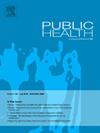Barriers to engagement in non-communicable disease prevention and public health care programs in Iran: A qualitative study
IF 3.9
3区 医学
Q1 PUBLIC, ENVIRONMENTAL & OCCUPATIONAL HEALTH
引用次数: 0
Abstract
Objectives
Despite the presence of comprehensive primary healthcare networks in Iran, which provide essential services for managing non-communicable diseases (NCDs) in both rural and urban areas, there is limited engagement with these prevention and care services. This study explores the reasons behind low participation in NCDs prevention and care programs.
Study design
Qualitative study.
Methods
This multicenter phenomenological qualitative study was conducted across three health centers (Valiasr, Tehransar, and Olympics) in western Tehran. The study employed face-to-face semi-structured in-depth interviews using purposive snowball sampling to select healthcare workers. Data saturation was achieved after 18 interviews. The principal investigator confirmed comprehension of the presented concepts, and data credibility was evaluated using various criteria. Data analysis was performed using Colaizzi's seven-step method. All qualitative analyses were performed using MAXQDA (version 2020).
Results
In total, 18 healthcare workers were interviewed. The findings revealed diverse challenges related to people, organizational deficiencies within health centers, and low motivation among healthcare workers. Challenges at the people level included prioritization of treatment over prevention services, economic difficulties, dissatisfaction with service quality, and lack of knowledge about NCDs prevention and care services. Organizational challenges included inadequate specialized services, single-shift operations at health centers, and registration issues within the National Electronic System. Additionally, burnout and low motivation were prevalent among healthcare workers.
Conclusion
This study highlights experiences that negatively impact NCD prevention and control efforts. Policymakers and health managers should consider these insights when planning strategies to enhance NCD services at health centers.
伊朗参与非传染性疾病预防和公共保健方案的障碍:一项定性研究
尽管伊朗拥有全面的初级保健网络,为管理农村和城市地区的非传染性疾病提供基本服务,但对这些预防和护理服务的参与有限。本研究探讨了非传染性疾病预防和护理项目参与率低的原因。研究设计定性研究。方法本多中心现象学定性研究在德黑兰西部的三个卫生中心(Valiasr、Tehransar和Olympics)进行。本研究采用面对面半结构化的深度访谈,采用有目的的滚雪球抽样来选择卫生保健工作者。18次访谈后达到数据饱和。主要研究者确认对所提出的概念的理解,并使用各种标准评估数据的可信度。数据分析采用Colaizzi的七步法。所有定性分析均使用MAXQDA(2020版)进行。结果共访谈18名医护人员。研究结果揭示了与人有关的各种挑战,卫生中心的组织缺陷,以及卫生工作者的低动机。人民层面的挑战包括治疗优先于预防服务、经济困难、对服务质量的不满以及缺乏对非传染性疾病预防和护理服务的了解。组织方面的挑战包括专业服务不足、卫生中心的单班制操作以及国家电子系统内的注册问题。此外,职业倦怠和低动机在医护人员中普遍存在。结论本研究突出了对非传染性疾病防控工作产生负面影响的经验。政策制定者和卫生管理人员在规划加强卫生中心非传染性疾病服务的战略时应考虑这些见解。
本文章由计算机程序翻译,如有差异,请以英文原文为准。
求助全文
约1分钟内获得全文
求助全文
来源期刊

Public Health
医学-公共卫生、环境卫生与职业卫生
CiteScore
7.60
自引率
0.00%
发文量
280
审稿时长
37 days
期刊介绍:
Public Health is an international, multidisciplinary peer-reviewed journal. It publishes original papers, reviews and short reports on all aspects of the science, philosophy, and practice of public health.
 求助内容:
求助内容: 应助结果提醒方式:
应助结果提醒方式:


